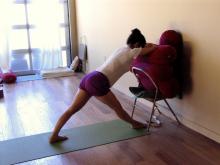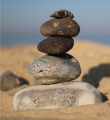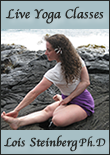Parsvottanasana

- From Tadasana, Inhale and step or jump into Utthita Hasta Padasana. Turn the whole body towards the right leg.
- Exhale hands to hips.
- Inhale lift the chest up.
- Exhale place the hands on the floor or on blocks. Keep the spine concave. The inner shoulderblades move into the spine.
- The legs and arms are straight. The pelvis is parallel with the floor and the center of the chest is in line with the center of the thigh.
- Take a few deep breaths here drawing up on the front thighs. Extend through the outer edge of the back foot. Extend the front hip back and the back hip forward. Inhale.
- Exhale extend the spine over the legs drawing the chin towards the shin.
- Inhale. Lift the chest to the spine concave again. Exhale the hands to the hips. Inhale the torso back to vertical. Exhale return to Utthita Hasta Padasana and rotate the left foot out 90 degrees and back foot in 75-80 degrees. Repeat on the other side.
Actions
WATCH YOUR TIME. TEACH BOTH CONCAVE AND CONVEX ON FIRST TEACHING.
From Tadasana, take the hands behind the back into Pascima Namaskarasana. Inhale and step or jump the legs wide apart about 3 - 3.5 feet. Turn the whole body towards the right leg. Alignment of the Feet- Do not walk a tightrope. Front heel in line with the inner edge of the back heel. Front foot turns out 90 degrees and Back foot turns in 75- 80 degrees.
Inhale lift the chest up. Open the armpits. Take the chin towards the ceiling and roll the outer shoulders and elbows back. (Now raise the trunk and head as far back as you can without bending the legs. This movement should be done with one inhalation. )
Exhale forward but keep the spine concave. The inner shoulder blades move into the spine.
The legs are straight. The pelvis is parallel with the floor and the center of the chest is in line with the center of the thigh. Stretch the sides of the abdomen and broaden the chest.
Take a few deep breaths. Draw up on the front thighs. Extend through the outer edge of the back foot. Draw the front hip back and the back hip forward. Inhale.
Exhale extend the spine over the legs, extend the chest towards the toes. Extend the sides of the trunk downwards and rest the head on the knee.
Inhale. Lift the chest to the spine concave again. Exhale. Inhale the torso back to vertical.Exhale return to Utthita Padasana and rotate the left foot out 90 degrees and back foot in 75-80 degrees. Repeat on the other side.
Additional Actions:
Press into the big toe mound of both feet to internally rotate thighs.
Pull the abdomen towards the spine. Lift the torso out of the pelvis.
Extend towards the head to reach the knee. Stretch the spinal column from the navel to the chin.
Reach arms forward to lengthen the side waist. Draw the shoulder blades into the back to lengthen the spine forward.
Extend the back of neck.
Shoulders down the back and elbows in.
first, set up the actions in the arms and the legs. do the pose first in front of the students, so the voice is not always behind the pose. basic action - press the feet and take the thigh back. need to have equal weight in the feet. most people put more weight into the front leg so bring more weight into the back leg. make demo more dramatic. if you press something down, what goes up. what is stable and what moves? don’t just say what but how.
Learn to press the left heel. Keep the face, trunk, right thigh and the right knee in line to the right foot. Keep both knees straight, tight and firm. Note: This asana helps to perform parivrtta kriya with ease. This asana can also be performed on the right side with the left arm up and right below and vice versa. - Geeta Iyengar, Intermediate Course
Common Issues:
Hands cannot maintain pascima namaskar
Shoulders and elbows collapse forward
Legs are not straight
Pelvis is not level (front hip forward and up, back hip back and down)
Sides of waist collapsed
This asana relieves stiffness in the legs, neck, shoulders, elbows and wrists. It relieves stiffness in the hip muscles and makes the hip joints and spine elastic. Abdominal organs are contracted and toned. In the final pose, the shoulders are drawn well back and this makes breathing easier. This pose calms the brain.
Press into the big toe mound of both feet to internally rotate thighs.
Pull the abdomen towards the spine. Lift the torso out of the pelvis.
Extend towards the head to reach the knee. Stretch the spinal column from the navel to the chin.
Reach arms forward to lengthen the side waist. Draw the shoulder blades into the back to lengthen the spine forward.
Extend the back of neck.
If the hands are unable to reach the floor, then use bricks on either side of the leg and keep the palms on them.
Learn these movements braking the actions in three steps by attempting once on the right and once on the left. 1. Palms on the waist, turn the trunk to the side and head back. 2. Hands down and concave back. 3. Head down.
Learn to do the movements in continuity on the right side as well as the left side.
Learn to develop insight by bringing inner attention while performing asana. Have a single link of attention though the movements are different.
All of the movements of the arms are important for students affected with arthritis, rheumatism and so on. - Geeta Iyengar, Preliminary Course.
- Place hands on blocks or a chair to help lift and lengthen the spine and side waist.
- Baddha Mani Bandha Parsvottanasana - Hold either wrists behind the back.
- Baddha Hasta Parsvottanasana - Hold either elbow behind the back.
- Paschima Namaskara - Hands in Namaskarasana behind the back.
During Pregnancy, keep the chest lifted. Place the hands on blocks or a chair to maintain space in the abdomen.
Are you a Yoga Teacher?
Are you a Yoga Student?
Do you Own a Yoga Studio?



